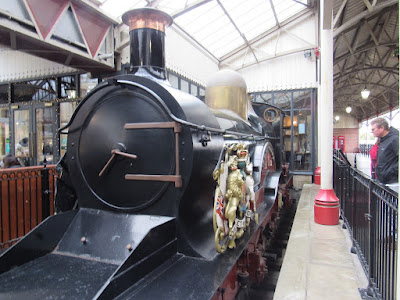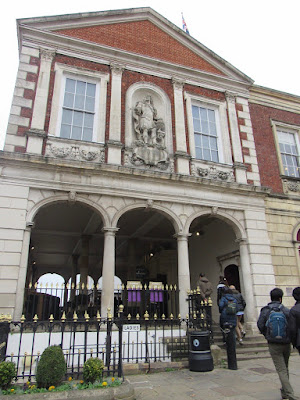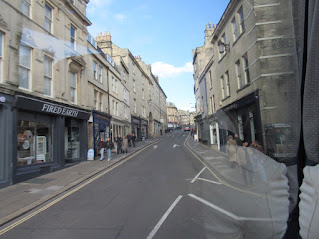We left Cardiff around 9 a.m. and headed back to England, to Bath, a short journey of about an hour and a half. We crossed the Severn Estuary, which creates the border between Wales and England. It runs for 160 miles from the Dee estuary, in the north, to the Severn estuary in the south. It is a treacherous body of water to cross at low tide because of its marshland.
People have lived in this area for thousands of years. Alfred the Great was the first to unite all the kingdoms in this area, and he is credited with founding England. He was deposed by the Vikings but managed to fight back.
The County of Somerset is part of the ancient Kingdom of Wessex. The rolling hills of Somerset are very fertile. They form a deep valley for the Avon River. The Avon is a tributary of the Thames River that passes through London. Bath was a fording point across the Avon River and as a result became a trading post.
The Mendip Hills are largely composed of carboniferous limestone, which is quarried at several sites. Ash and maple woodlands cover the area and provide habitat for a range of flora and fauna. These were great hunting grounds and they provided an east-west trade route to London.
Bath, a small town in southwestern England, has been known and named for the baths the Romans built there in 60 CE. They were fed by hot springs. Bath is located along the Avon River. Bath Abbey
was founded in the 7th century and the town became a religious center. The
building was rebuilt in the 12th and 16th centuries. In the 17th
century, as claims were made for the curative properties of water from the hot
springs, Bath became popular as a spa town in the Georgian era.
The hot sulfurous spring there were seen as magical as well as spiritual by the Britons who worshipped Nature. They had restorative powers to heal the sick. The earliest account of this is in the 5th century. Venerable Bede (673-735), a monk at the monastery of St Peter and its companion monastery of St Paul in the Kingdom of Northumbria of the Angles, wrote about it in one of the first histories of the Britons.
There is also a story about Prince Bladat, the son of King Lear, who had an itch and rash. He was banished to live in the wild forest. One day, he was sitting on a rock and he saw a herd of swine looking pretty crusty. They rolled in the mud of the hot spring and got better. So, he tried it himself and he recovered from his skin disease. He later became king. This story went as far as Greece because the Britons had traded with cities on the Mediterranean for thousands of years.
In the first century C.E., the Roman came here and discovered the hot springs. They liked to bath so this region became a resort for them--a break from the cold, wet, and unfriendly climate. 
Bath was a medieval town. In the 18th century, science and new discoveries encouraged people to return to ancient classical values. So they tore down the city and copied Italian neo-classical architecture, which is called Paladian style. (The White House in Washington, D.C. follows this same style.) John Nash (1752-1835), was one of the foremost British architects of the Georgian and Regency eras, during which he was responsible for the design, in the neoclassical and picturesque styles, of many important areas of London. He designed Buckingham Palace and the Marble Arch.
He designed the new Bath with the idea that the city is "a work of art" and shouldn't be over-crowded. He used yellow limestone for building materials, built wide streets, and used symmetry. The bridge over the Avon River (top photo) is based on the Ponte Vecchio in Florence. Consequently, he made Bath the most fashionable city in Europe. Many people flocked there to enjoy its ambience and to be seen. 
A river walkway (left) and a park further down the road with mansions in the background.
The
Circus (the Royal Crescent) is an example of Georgian architecture begun in 1754 and completed in 1768. The name comes
from the Latin 'circus', which means a ring, oval or circle.The Circus
was designed by John Wood the Elder, although he died less than three months
after the first stone was laid. His son, John Wood the
Younger completed the building.

There were also concert halls, lectures, and poetry readings held in Bath. It was all about leisure and pleasure. It was a place where the wealthy British aristocrats went, especially for matchmaking. Bath was a retreat from troubles at home and a fresh start after indulging in the beauty of the town's spas and parks. It was also a place the wealthy merchant class went to marry off their children to the gentry class that had high social status but not necessarily any money.
My exposure to Bath was through two women: Jane Austen and Chaucer's Wife of Bath. It was exciting to be in a place I'd read about. I didn't know what to expect.
Jane Austen (1775–1817) wrote six major novels, which interpret, critique, and comment upon
the British landed gentry
at the end of the 18th century. Two of her novels have scenes in Bath. Her plots often explore the
dependence of women on marriage in the pursuit of favorable social
standing and economic security. She used biting irony, along with realism and social commentary.
 Geoffrey Chaucer in The Canterbury Tales
(1405-10) made one of his major characters the Wife of Bath, a somewhat
loose and sensual woman who was married five times. She complains about
the double standards of men and women who do the same. Women were identified not by their social status and occupations, but
solely by their relations with men: a
maiden, a spouse or a widow – capable only of child-bearing, cooking and
other "women's work".
Geoffrey Chaucer in The Canterbury Tales
(1405-10) made one of his major characters the Wife of Bath, a somewhat
loose and sensual woman who was married five times. She complains about
the double standards of men and women who do the same. Women were identified not by their social status and occupations, but
solely by their relations with men: a
maiden, a spouse or a widow – capable only of child-bearing, cooking and
other "women's work".
Bath Abbey
Although it started out as a convent in 676, in the 8th century, Bath Abbey was founded as a Benedictine monastery. Its community was committed to worshipping God, justice for the poor, and hospitality to all people. The Abbey is now a parish church still guided by the same values, says a pamphlet.
The Abbey is one of the largest examples of Perpendicular Gothic architecture in the West Country. It is the third and final style of medieval
Gothic architecture in England. It is characterized by an emphasis on
vertical lines.
The style began to emerge in about 1330.

A very unique structure on the exterior flanking the main doors was Jacob's Ladder with angels attempting to climb it to reach God. This was a first for me--and quite a delightful first. Some of them make it, and some of them don't.



As a Gothic church,
light was everything. The light in this church was brilliant as the
sanctuary and the surrounding narthex stained glass windows let the
light flood in. It was a magnificent display of color!

The ceiling was most amazing. Its lace-like design reminded me of a church in Sicily, only this ceiling was more symmetrical.

The talents of the artisan's wood carvings of the pulpit and monks' stalls were carefully preserved and on display.

The British seem to like putting graves in the floors of their cathedrals and abbeys. This one was no different. Here are a few of the older gravestones.

And a few interesting monuments to the dead as well.



The Tomb of Jane, wife of Sir William Waller who commanded the
Parliamen-tary forces against the Royalists under Sir Ralph Hopton at the
Battle of Lansdown in 1643. Sir William Waller erected the tomb to the
memory of his wife and made provision for his own burial here. He was,
however, buried in the Tothill Street Chapel, Westminster.
Finally, a plaque commemorated the visit of Queen Elizabeth and Prince Philip on August 9, 1973.
Bath is certainly a wonderful place to visit! It's worth coming back to and indulging in some of its pleasures, like the hot springs, the parks, and the interesting shops. One shop I visited but didn't photograph was the meat pie shop. Our guide highly recommended this taste of the local food for our lunch. After all, our bus was waiting to take us to Windsor, our last stop on this miles-long tour.
Resources
Andrew Speed, guide for Costsaver Travel Company
Jane Austen -- https://en.wikipedia.org/wiki/Jane_Austen
The Wife of Bath -- https://en.wikipedia.org/wiki/The_Wife_of_Bath%27s_Tale
Bath -- https://en.wikipedia.org/wiki/Bath,_Somerset
Perpendicular Gothic -- https://en.wikipedia.org/wiki/English_Gothic_architecture#Perpendicular_Gothic


























































